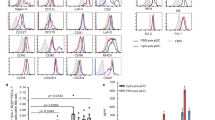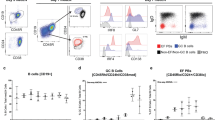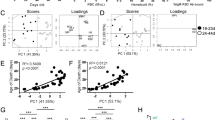Abstract
We have previously shown that a granulocyte-macrophage colony–stimulating factor (GM-CSF) and interleukin-15 (IL-15) 'fusokine' (GIFT15) exerts immune suppression via aberrant signaling through the IL-15 receptor on lymphomyeloid cells. We show here that ex vivo GIFT15 treatment of mouse splenocytes generates suppressive regulatory cells of B cell ontogeny (hereafter called GIFT15 Breg cells). Arising from CD19+ B cells, GIFT15 Breg cells express major histocompatibility complex class I (MHCI) and MHCII, surface IgM and IgD, and secrete IL-10, akin to previously described B10 and T2-MZP Breg cells, but lose expression of the transcription factor PAX5, coupled to upregulation of CD138 and reciprocal suppression of CD19. Mice with experimental autoimmune encephalomyelitis went into complete remission after intravenous infusion of GIFT15 Breg cells paralleled by suppressed neuroinflammation. The clinical effect was abolished when GIFT15 Breg cells were derived from mμMT (lacking B cells), MHCII-knockout, signal transducer and activator of transcription-6 (STAT-6)-knockout, IL-10–knockout or allogeneic splenocytes, consistent with a pivotal role for MHCII and IL-10 by sygeneic B cells for the observed therapeutic effect. We propose that autologous GIFT15 Breg cells may serve as a new treatment for autoimmune ailments.
This is a preview of subscription content, access via your institution
Access options
Subscribe to this journal
Receive 12 print issues and online access
$209.00 per year
only $17.42 per issue
Buy this article
- Purchase on Springer Link
- Instant access to full article PDF
Prices may be subject to local taxes which are calculated during checkout






Similar content being viewed by others
References
Kuhlmann, T. et al. Continued administration of ciliary neurotrophic factor protects mice from inflammatory pathology in experimental autoimmune encephalomyelitis. Am. J. Pathol. 169, 584–598 (2006).
Jack, C., Ruffini, F., Bar-Or, A. & Antel, J.P. Microglia and multiple sclerosis. J. Neurosci. Res. 81, 363–373 (2005).
O'Connor, K.C., Bar-Or, A. & Hafler, D.A. The neuroimmunology of multiple sclerosis: possible roles of T and B lymphocytes in immunopathogenesis. J. Clin. Immunol. 21, 81–92 (2001).
The IFNB Multiple Sclerosis Study Group. Interferon β-1b is effective in relapsing-remitting multiple sclerosis. I. Clinical results of a multicenter, randomized, double-blind, placebo-controlled trial. The IFNB Multiple Sclerosis Study Group. Neurology 43, 655–661 (1993).
Panitch, H., Miller, A., Paty, D. & Weinshenker, B. Interferon β-1b in secondary progressive MS: results from a 3-year controlled study. Neurology 63, 1788–1795 (2004).
Johnson, K.P. et al. Copolymer 1 reduces relapse rate and improves disability in relapsingremitting multiple sclerosis: results of a phase III multicenter, double-blind placebo-controlled trial. The Copolymer 1 Multiple Sclerosis Study Group. Neurology 45, 1268–1276 (1995).
Hartung, H.P. et al. Mitoxantrone in progressive multiple sclerosis: a placebo-controlled, double-blind, randomised, multicentre trial. Lancet 360, 2018–2025 (2002).
Krapf, H. et al. Effect of mitoxantrone on MRI in progressive MS: results of the MIMS trial. Neurology 65, 690–695 (2005).
Polman, C.H. et al. A randomized, placebo-controlled trial of natalizumab for relapsing multiple sclerosis. N. Engl. J. Med. 354, 899–910 (2006).
Dhib-Jalbut, S. et al. Effect of combined IFNβ-1a and glatiramer acetate therapy on GA-specific T cell responses in multiple sclerosis. Mult. Scler. 8, 485–491 (2002).
Arnold, D.L. et al. Glatiramer acetate after mitoxantrone induction improves MRI markers of lesion volume and permanent tissue injury in MS. J. Neurol. 255, 1473–1478 (2008).
Stern, J.N. et al. Amino acid copolymerspecific IL-10–secreting regulatory T cells that ameliorate autoimmune diseases in mice. Proc. Natl. Acad. Sci. USA 105, 5172–5176 (2008).
Giorgini, A. & Noble, A. Blockade of chronic graft-versus-host disease by alloantigeninduced CD4+CD25+Foxp3+ regulatory T cells in nonlymphopenic hosts. J. Leukoc. Biol. 82, 1053–1061 (2007).
Karim, M., Feng, G., Wood, K.J. & Bushell, A.R. CD25+CD4+ regulatory T cells generated by exposure to a model protein antigen prevent allograft rejection: antigen-specific reactivation in vivo is critical for bystander regulation. Blood 105, 4871–4877 (2005).
Fassas, A. et al. Hematopoietic stem cell transplantation for multiple sclerosis. A retrospective multicenter study. J. Neurol. 249, 1088–1097 (2002).
Rafei, M. et al. GM-CSF and IL-15 fusokine leads to paradoxical immunosuppression in vivo via asymmetrical JAK/STAT signaling through the IL-15 receptor complex. Blood 109, 2234–2242 (2007).
Horcher, M., Souabni, A. & Busslinger, M. Pax5/BSAP maintains the identity of B cells in late B lymphopoiesis. Immunity 14, 779–790 (2001).
Prêle, C.M. et al. SOCS1 Regulates the IFN but Not NFκBpPathway in TLR-stimulated human monocytes and macrophages. J. Immunol. 181, 8018–8026 (2008).
Fillatreau, S., Sweenie, C.H., McGeachy, M.J., Gray, D. & Anderton, S.M. B cells regulate autoimmunity by provision of IL-10. Nat. Immunol. 3, 944–950 (2002).
Kitamura, D., Roes, J., Kuhn, R. & Rajewsky, K.A. B cell–deficient mouse by targeted disruption of the membrane exon of the immunoglobulin mu chain gene. Nature 350, 423–426 (1991).
Wolf, S.D., Dittel, B.N., Hardardottir, F. & Janeway, C.A. Jr. Experimental autoimmune encephalomyelitis induction in genetically B cell-deficient mice. J. Exp. Med. 184, 2271–2278 (1996).
Matsushita, T., Yanaba, K., Bouaziz, J.D., Fujimoto, M. & Tedder, T.F. Regulatory B cells inhibit EAE initiation in mice while other B cells promote disease progression. J. Clin. Invest. 118, 3420–3430 (2008).
Yanaba, K. et al. A regulatory B cell subset with a unique CD1dhiCD5+ phenotype controls T cell-dependent inflammatory responses. Immunity 28, 639–650 (2008).
Evans, J.G. et al. Novel suppressive function of transitional 2 B cells in experimental arthritis. J. Immunol. 178, 7868–7878 (2007).
Mauri, C., Mars, L.T. & Londei, M. Therapeutic activity of agonistic monoclonal antibodies against CD40 in a chronic autoimmune inflammatory process. Nat. Med. 6, 673–679 (2000).
Lau, A.W., Biester, S., Cornall, R.J. & Forrester, J.V. Lipopolysaccharide-activated IL-10–secreting dendritic cells suppress experimental autoimmune uveoretinitis by MHCII-dependent activation of CD62L-expressing regulatory T cells. J. Immunol. 180, 3889–3899 (2008).
Brummel, R. & Lenert, P. Activation of marginal zone B cells from lupus mice with type A(D) CpG-oligodeoxynucleotides. J. Immunol. 174, 2429–2434 (2005).
Fornek, J.L. et al. Critical role for Stat3 in T-dependent terminal differentiation of IgG B cells. Blood 107, 1085–1091 (2006).
Bouaziz, J.D., Yanaba, K. & Tedder, T.F. Regulatory B cells as inhibitors of immune responses and inflammation. Immunol. Rev. 224, 201–214 (2008).
Singh, A.K. et al. Natural killer T cell activation protects mice against experimental autoimmune encephalomyelitis. J. Exp. Med. 194, 1801–1811 (2001).
Mann, M.K., Maresz, K., Shriver, L.P., Tan, Y. & Dittel, B.N. B cell regulation of CD4+CD25+ T regulatory cells and IL-10 via B7 is essential for recovery from experimental autoimmune encephalomyelitis. J. Immunol. 178, 3447–3456 (2007).
Mizoguchi, A., Mizoguchi, E., Takedatsu, H., Blumberg, R.S. & Bhan, A.K. Chronic intestinal inflammatory condition generates IL-10–producing regulatory B cell subset characterized by CD1d upregulation. Immunity 16, 219–230 (2002).
Singh, A. et al. Regulatory role of B cells in a murine model of allergic airway disease. J. Immunol. 180, 7318–7326 (2008).
Jamin, C. et al. Regulatory B lymphocytes in humans: A potential role in autoimmunity. Arthritis Rheum. 58, 1900–1906 (2008).
Rafei, M. et al. Selective inhibition of CCR2 expressing cells in experimental autoimmune encephalomyelitis by a GM-CSF_MCP1 fusokine. J. Immunol. 182, 2620–2627 (2009).
Acknowledgements
M.R. is a recipient of a Fonds de Recherches en Santé du Québec Scholarship, and J.G. is a Fonds de Recherches en Santé du Québec chercheur-boursier sénior. C.P. holds a Canada Research Chair in Immunobiology. This work was supported by the Canadian Institute of Health Research grant MOP-15017.
Author information
Authors and Affiliations
Contributions
M.R. designed the research plan, performed most experiments, analyzed results and wrote the manuscript. J.H. performed APC assays. S.Z. induced EAE. M.L. performed cell culture and ELISAs. K.F. and E.B. handled mice. M.-N.B. performed CFSE experiments. Y.K.Y. performed cell death and cell cycle experiments. C.P. analyzed results and provided guidance. J.G. designed the research plan, analyzed results and wrote the manuscript.
Corresponding author
Rights and permissions
About this article
Cite this article
Rafei, M., Hsieh, J., Zehntner, S. et al. A granulocyte-macrophage colony–stimulating factor and interleukin-15 fusokine induces a regulatory B cell population with immune suppressive properties. Nat Med 15, 1038–1045 (2009). https://doi.org/10.1038/nm.2003
Received:
Accepted:
Published:
Issue Date:
DOI: https://doi.org/10.1038/nm.2003
This article is cited by
-
The molecular basis of chaperone-mediated interleukin 23 assembly control
Nature Communications (2019)
-
Adoptive transfer of IL-10+ regulatory B cells decreases myeloid-derived macrophages in the central nervous system in a transgenic amyotrophic lateral sclerosis model
Cellular & Molecular Immunology (2018)
-
B cell regulation in cancer and anti-tumor immunity
Cellular & Molecular Immunology (2017)
-
Expanding Diversity and Common Goal of Regulatory T and B Cells. I: Origin, Phenotype, Mechanisms
Archivum Immunologiae et Therapiae Experimentalis (2017)
-
New Insights into IL-10 Dependent and IL-10 Independent Mechanisms of Regulatory B Cell Immune Suppression
Journal of Clinical Immunology (2016)



